Python is a programming language that is gaining popularity year after year, not only in the global programming community but also among customers.
We refer those interested in tracking the popularity of individual languages to the TIOBE Index.
Python is an open-source project that has been developed, refined, and improved over the years by numerous dedicated programmers and researchers.
The community not only improves the language but also develops and creates new frameworks that significantly accelerate programming work.
In particular, regarding the creation and development of web and mobile applications.
At least a dozen of the most popular frameworks are written in Python. We want to take this opportunity to recommend our article "The best Python frameworks for web development."
In numerous discussions, rankings, reports, and descriptions of trends, perhaps the most frequently mentioned are the Django Web Framework and Flask Web Framework.
The trade press often compares them (Python Django vs. Flask), mainly due to the high popularity of both frameworks among web developers.
What advantages and what imperfections distinguish these two frameworks? What is the scope of their application?
To whom and for what purposes is the Django framework recommended? Who should use Flask, and for what reasons?
Which Python framework should you choose? What do these two solutions have in common, and what are their respective features? How to select a framework for the project we intend to undertake?
We have just raised some very important questions that definitely deserve detailed answers.
So let's get started!
Django — what is it?
Django is one of the free and open-source web frameworks written in Python programming language. The article "Flask vs Django" provides a very nice and to-the-point definition of it.
Django is a high-level Python Web framework that encourages rapid development and clean, pragmatic design.
With its help, you can develop high-performing web apps in a short time. It takes care of any basic development functions, enabling you to focus entirely on creating the desired application.
Flask — what is it?
Flask is a Python micro-framework that doesn't rely on external libraries. It was created with speed in mind, allowing you to start the web application development very quickly. Thanks to that, it's also very easy to learn.
Why use frameworks at all?
Before we start the comparison of Django and Flask, it would be good to mention the overall benefits of using frameworks in web development.
So, why would you even use them?
Frameworks considerably facilitate the entire web development process. They help you through repetitive elements like building back-end logic or designing a user interface.
Frameworks provide many ready-made components and libraries that further facilitate the creation of applications. Thanks to them, you don't have to reinvent the wheel.
Web frameworks can help you focus on building critical features of an application.
They are usually developed by a vast and dedicated community of developers, meaning they're continuously improved, optimized, and tested.
These characteristics make them an ideal solution for cost-effectively developing projects.
Python Flask vs. Django – basic differences
Which framework is better? This is one of the most common questions posed by young programming enthusiasts.
The question about the most appropriate technology, a tool written in Python, also comes up quite often from clients of web development companies.
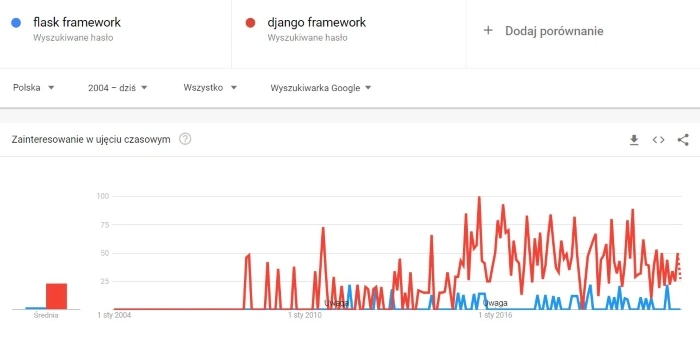
Should I choose Django or Flask? Which one is better? These kinds of questions sound very natural and seem to be relevant. But are they? Yes and no.
Yes, because knowledge and awareness of the differences between the two frameworks allow us to make accurate and rational choices.
No, because the framework should not be selected due to the result of comparing its functions with functions, way of working, and features of competing solutions, but because of the adequacy and usefulness of its functions in a particular project.
We should choose a framework not because of, more or less subjective, benchmarks but because of the functionalities of a given framework that we will use to build a web app.
Of course, Django and Flask are used to create web applications whose interface is often based on HTTP, REST, and GraphQL protocols.
Both Flask and Django have built-in support for testing. They also have in common several other functions and roles they can perform.
In a very general sense, they serve very similar purposes. However, when we take a closer look at them, we will find out that they have a lot of differences.
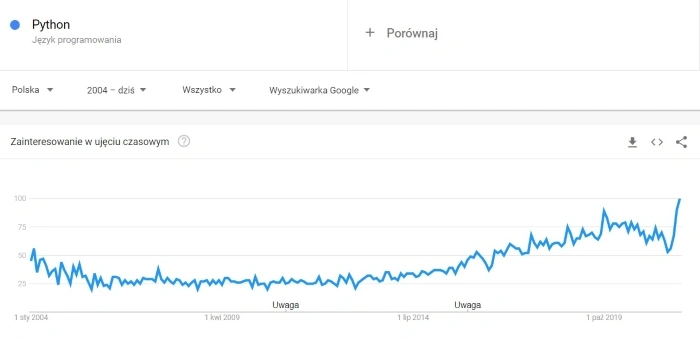
Although both frameworks are written in the same language (Python), they differ significantly. Above all, they belong to two different categories.
Frameworks in the most basic division are split into two types:
- Full-stack frameworks
- Micro-frameworks
Micro-frameworks
Micro-frameworks are used to create very simple applications. They are also sometimes used to develop application prototypes and MVPs (Minimum Viable Products).
A Micro-framework typically supports request routing and gives access to a set of tools to handle an HTTP request and return some sort of response.
Full-stack frameworks
Full-stack Frameworks are used to build advanced and complex applications that are demanding to create, develop, and maintain.
Above all, they provide many more necessary tools to create a complete web application.
They typically offer:
- Request routing
- Request processing
- MVC
- ORM (Object-Relational Mapping)
- Code generators and automation tools
- Template engines
- Validations
- Solutions supporting security.
Django is a full-stack web framework, while Flask is a framework with limited functions, but it offers the option to extend their scope.
The Django web development framework is recommended for:
- Projects where the speed of deployment is a key value
- Applications whose security level must be high without the need for additional specialized tools
- Data-driven applications and platforms.
The Flask web development framework is recommended for:
- Microservices and very simple web applications
- High-load web applications and RESTful web services
- APIs.
What are the most important characteristics of the Django framework?
Django is a framework with obvious advantages, but it has its limitations.
It is recommended because of its capability to create applications that are safe and easy to maintain.
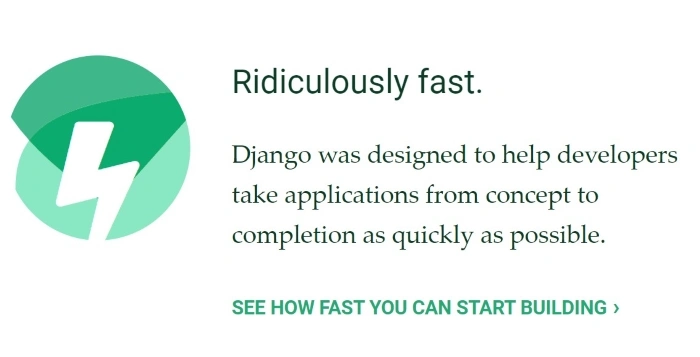
It provides the majority of typical functionalities, tools, and solutions.
It is often emphasized that when developers use Django, all they need to do is create a business logic because the framework handles all the rest.
Above all, Django is a very versatile framework, capable of creating various applications.
The use of the framework itself does not pose many problems. Django is easy to configure and does not raise issues during use, primarily due to its clear and intuitive interface.
Moreover, the Django framework offers the following:
- Internationalization system, which allows developers to create pages in different language versions
- Tools for multidimensional application testing
- Built-in authentication system
- Built-in protection against common types of malicious attacks (including XSS, SQL injection)
- ORM system, data models, and database versioning system
- Dynamic HTML pages
- Speed and simplification of the application development process
- Reusable components
- Tools necessary to implement scalable and easy-to-maintain functionalities
- Support for asynchronous views
- Template engines
- Django admin.
Django, like any tool, is not perfect. It has limitations and imperfections.
Its most common drawbacks include the following:
- Monolithic nature
- Relatively slow performance
- Dependence on ORM
- Interdependencies between migrations.
Key characteristics of the Flask framework
As we have already written, Flask belongs to a different category of frameworks, so it also has different capabilities and functions and serves different purposes.
Flask requires much more independence and invention from its users. For example, a Flask user has to find and add libraries on their own.
Flask is not as compact and has a narrower scope of applicability, but it is also much more flexible, simple, and easy to learn and master than Django.
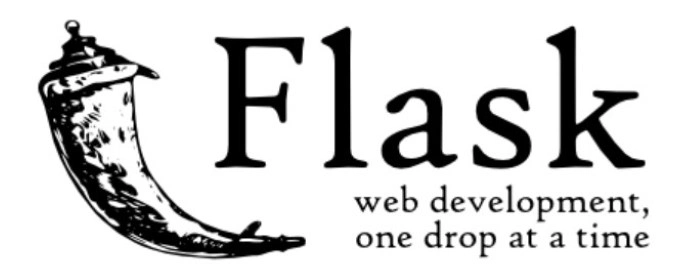
Especially since the offered documentation is clear and exhaustive.
The Flask framework provides developers with the following:
- Control over crucial decisions during application development
- Highly flexible project configuration
- Diversified working style
- Support for HTTP requests
- Compatibility with the latest technologies
- High scalability
- Easy URL routing
- A minimalistic core that is easily extensible
- Less vulnerability to malicious attacks
- Ability to deploy on serverless platforms.
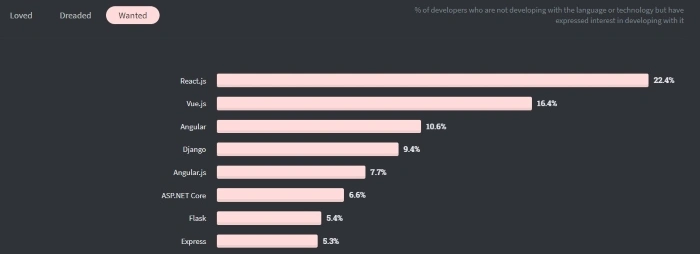
Flask's drawbacks most often include:
- Lack of tools that solve common web application problems, such as authorization and authentication, ORM, or data validation.
- Requires much more experience from developers in terms of developing web applications.
- Simplicity requires the development of architecturally well-thought-out applications, which requires much more planning for large projects.
- Lack of convention and a defined project structure.
Which framework should you learn first?
In the article "Django vs. Flask in 2023: Which Framework to Choose," Michael Herman recommends learning Flask first.
According to him, starting with Flask enables you to learn fundamental principles and best practices of web development.
Since it's a lightweight framework, it's easier to use, especially if you are already familiar with Python. Working with Flask is like working with a trial version of Python.
In general, Flask provides more opportunities to learn, and its learning curve is not as steep as Django.
In comparison, Django is much more complex and extensive. It has many features you may not know what to do with. Therefore, if you are a beginner, Django may cause you much more trouble and frustration than it's worth.
Hiring trends
The abovementioned article also provides some insight into industry trends and which types of programmers are desirable on the market.
According to it, even though Python and Django are massively popular, it isn't easy to find Django developers, especially if you're looking for someone who is not a senior and, therefore, less expensive.
Industry trends
Industry trends suggest that the popularity of microservices causes beginner developers to learn more lightweight frameworks, and increasingly, more often, web developers choose the following programming languages: JavaScript, Ruby, and Python as their first language.
Difficulty of learning
The difficulty of learning also influences these trends. Unfortunately, there is a lack of suitable, beginner-tailored Django tutorials, and the Django documentation itself, although extensive and comprehensive, is not beginner-friendly.
When we consider these factors, Flask seems to be a good choice for learning first. Although it's not significantly easier to find a job involving it, it has the advantage of being a lightweight framework.
Examples of use
The article "Flask vs Django: How to Understand Whether You Need a Hammer or a Toolbox" provides some examples of applications and websites that made use of either Django or Flask.
The Django framework was used to create the following:
- Spotify
- The Washington Post
- Dropbox
- Mozilla
Flask was used to build the following:
- Red Hat
- RackSpace
- Airbnb
- Netflix
- Lyft
As you can see, both of these solutions find their application, and their selection is a matter of finding out what you and our project need.
Flask vs. Django – a comparison of Python frameworks. Summary
- Python, Django, and Flask are growing in popularity every year.
- Python, Django, and Flask communities develop frameworks that significantly speed up programming and web development.
- Comparisons of frameworks written in Python (e.g., Django vs. Flask) are often made.
- Frameworks (e.g., Django and Flask) should be chosen based on the criterion of relevance and the usefulness of their functions in a given project.
- Choosing a framework based on subjective benchmarks is not a correct approach. It is definitely better to pay attention to the functionalities of a given framework.
- Django and Flask are used to create web applications whose interface is most often based on HTTP, REST, and GraphQL protocols.
- Flask and Django have built-in support for testing.
- To summarize the comparison between Django and Flask, it must be said that Django is a Full-Stack framework while Flask is a Microframework.
- Microframeworks are used to develop very simple applications, application prototypes, and MVPs (Minimum Viable Products).
- Full-stack frameworks are used to develop advanced, complex applications and provide more tools necessary to create a complete web application.
- Django is recommended for developing data-driven applications and platforms where the speed of deployment is crucial, and the level of security must be high without needing additional specialized tools.
- Flask is recommended for developing microservices and very simple web applications, high-load web applications and web services, and APIs.
- Django is a very versatile framework, capable of creating various applications.
- Flask is not as compact and has a narrower scope of applicability, but it is also much more flexible, simple, and easy to learn and master than Django.






